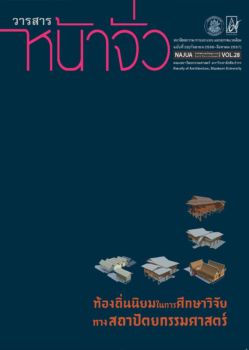การค้นหาทฤษฎีการวางผังออกแบบ จัตุรัสและลานหน้าอาคาร
Keywords:
พื้นที่ว่างสาธารณะในเมือง, จัตุรัสและลานหน้าอาคาร, การวางผังและออกแบบ, Urban Space, Square and Plaza, Planning and DesigningAbstract
บทความนี้เรียบเรียงมาจากงานวิจัยเรื่อง “การวางผังและออกแบบพื้นที่ว่างสาธารณะใน เมือง: ลานเมืองกรุงเทพมหานคร” ซึ่งมีวัตถุประสงค์บางข้อเพื่อศึกษาทฤษฎีการวางผังและออกแบบ จัตุรัสและลานหน้าอาคาร และการศึกษาประสบการณ์วางผังออกแบบจัตุรัส และลานหน้าอาคารที่ สำคัญและประสบความสำเร็จ ในการวิจัยได้ใช้วิธีการศึกษาจากเอกสาร ภาพถ่ายดาวเทียมและ แหล่ง ข้อมูลจากสื่ออิเล็กทรอนิกส์ ประกอบการสำรวจภาคสนามโดยผู้วิจัย
ผลการวิจัยสรุปได้ว่า ในทฤษฎีการวางผังออกแบบจัตุรัสและลานหน้าอาคาร คุณลักษณะที่ สำคัญของลานเหล่านี้ก็คือ หน้าที่ประโยชน์ใช้สอย (function) และรูปทรง (form) พื้นที่ว่างในเมือง ทั้งจัตุรัสและลานหน้าอาคารมีบทบาทหน้าที่และประโยชน์ใช้สอยที่สำคัญหลายอย่าง อาทิ เป็นที่ตั้ง สำหรับอาคารสาธารณะ สถานที่พบปะหลักของชุมชน สถานที่สำหรับพิธีการเฉลิมฉลองตามเทศกาล และวาระพิเศษ การบันเทิงเริงรมย์ พื้นที่วา่ งสำหรับการคา้ ขาย พื้นที่วา่ งโดยรอบกลุม่ อาคารสำนักงาน พื้นที่ว่างธรรมชาติกึ่งสาธารณะโดยรอบกลุ่มอาคารที่อยู่อาศัย ไปจนถึงพื้นที่ว่างที่สัมพันธ์กับชุม ทางการจราจรในเมือง จัตุรัสและลานหน้าอาคารจัดแบ่งออกได้ 5 ประเภทหลัก คือ จัตุรัสปิดหรือมี การโอบล้อม จัตุรัสที่มีอาคารโดดเด่น จัตุรัสรอบศูนย์กลาง จัตุรัสกลุ่ม และจัตุรัสเปิดพื้นที่เปิดโล่ง ทั้งจัตุรัสและลานหน้าอาคารมีความหมาย (meaning) ทั้งในทางสัญลักษณ์และการใช้ประโยชน์จริง คือ เป็นศูนย์กลาง (center) ของชุมชนและเมือง เป็นทางผ่านเข้าออกสำหรับสถานที่สำคัญ (portal for places) และความหมายทางสัญลักษณ์ (symbolic meaning) ส่วนประกอบที่สำคัญของจัตุรัส และ ลานหน้าอาคารได้แก่ (1) ผังพื้น (floor plan)ที่กำหนดรูปร่าง (shape) ของพื้นที่ว่าง (2) ผนัง (wall) หรือส่วนโอบล้อม (enclosure) ที่กำหนดขอบเขตพื้นที่ว่าง (3) เพดาน (ceiling)หรือส่วนปิดด้านบน ซึ่งได้แก่ท้องฟ้า หลักการที่สำคัญของการวางผังและออกแบบก็คือ (1) การกำหนดขอบเขตของพื้นที่ ว่าง (boundary) ที่แน่นอน (2) การสร้างการโอบล้อม (enclosure) ให้กับพื้นที่ว่างที่ชัดเจน และ(3) การสร้างนัยให้แก่สถานที่ (sense of place) ขนาดที่เหมาะสมของพื้นที่ว่างขึ้นอยู่กับระดับการโอบล้อม โดยทั่วไปอัตราส่วนระหว่างความยาวต่อความกว้างไม่ควรมากกว่า 3 : 1 อัตราส่วนที่ดีที่สุดก็ คือมีความยาวเป็นสองเท่าของความกว้าง สัดส่วนสูงสุดของความสูงอาคารต่อความกว้างลานควร จะเป็น 1 : 4 หรือไม่ควรตํ่ากว่า 1: 6 ระยะที่มากที่สุดไม่ควรเกิน 145 เมตรหากต้องการมองเห็นชัด ผังบริเวณควรมีรูปร่างที่ชัดเจน ควรมีการโอบล้อมทุกด้านด้วยอาคารที่สูงใกล้เคียงกัน มุมมองที่เห็น อาคารโอบล้อมได้ชัดเจนคือ 27 องศาหรือที่ระยะสองเท่าของความสูง ขอบเขตด้านบนหรือท้องฟ้า ได้รับการจินตนาการว่าอยู่สูงสามหรือสี่เท่าจากเส้นขอบหลังคาอาคารโอบล้อม
Searching for Theory in Planning and Designing of Square and Plaza
Sitthiporn Piromruen, Associate Professor
Department of Urban Design
Faculty of Architecture, Silpakorn University
This paper is excerpted from the research entitled “Planning and Designing of Public Urban Space: Bangkok City Plaza,” as some of the objectives of the research are to investigate the body of theory in planning and designing public space and to study empirical data of well-known squares and plazas in many parts of the world. Employed research methods include documentary study, literature reviews, and field survey. Data and images are obtained from various electronics sources as well.
The findings from the research are as follows: From the theory in planning and designing of squares and plazas viewpoint, basic attributes of such urban spaces are function and form. Major Role and function of both square and plaza include: setting for a civic building; principle meeting places; places for great ceremonial occasions; spaces for entertainment around buildings (such as theatres, cinemas, restaurants and cafes); spaces for shopping, shopping street, arcades and markets; spaces around which offices are grouped; spaces of a semi-public nature around which residential accommodation is arranged; as well as space associated with urban traffic junctions. Square and plaza can be categorized into 5 groups: (1) the closed square where space is self-contained; (2) the dominated square where space is directed towards the main building; (3) the nuclear square where space is formed around a center; (4) the grouped squares where spatial units are combined to form larger compositions; and (5) the amorphous square where space is unlimited. Symbolically and functionally, meanings of square and plaza are center of town and city, portal for places, and symbolic meaning. Significant components of square and plaza consist of layout plan as an indicator of shape and volume of space, walls or enclosures defined definite space, and the sky above is the ceiling for the square.
Main criteria in planning and designing are: (1) boundary of space should be well defined; (2) uniformed buildings should be introduced as enclosures of space; and (3) “sense of place” should be established as well. Size and proportion of square and plaza normally base on the degree of enclosure. Generally, proportion of space width and depth ratio should not more than 1: 3; a ratio of 1: 2 is the best. Meanwhile, proportion of building height and space depth ratio should be 1: 4, or not more than 1: 6. Floor plan or layout should be in geometry or certain forms. For a good viewing, a distance of 145 meters is recommended. Enclosing all sides with uniformed height is also advised. Angle of 27 degree or a distance of twice building height is an ideal for seeing all enclosures. The ceiling of square or plaza is perceived to be 3 or 4 times above the tallest building at the perimeter.





